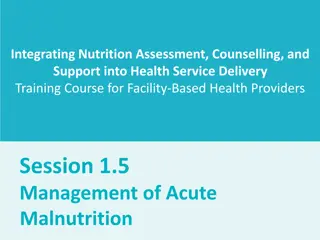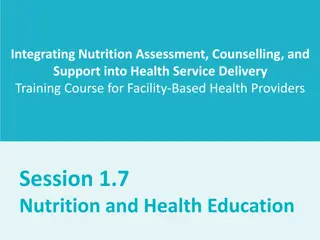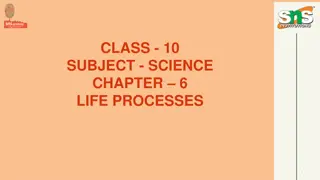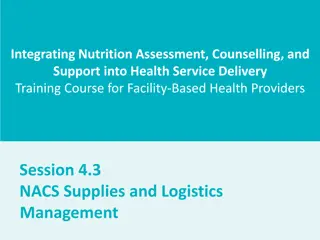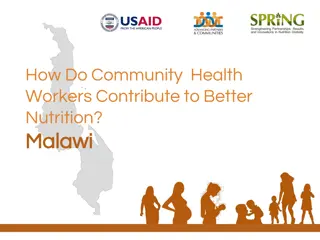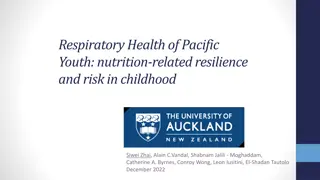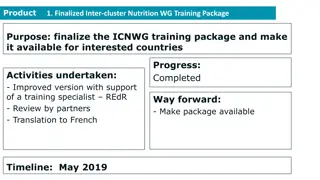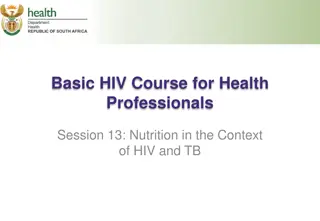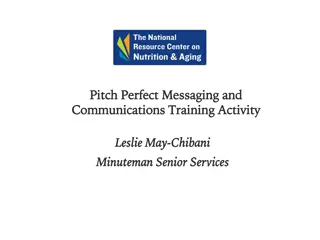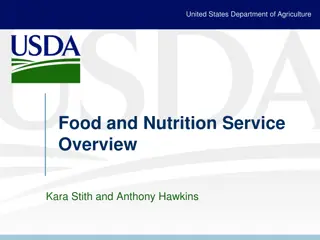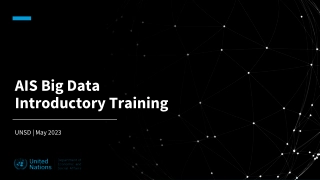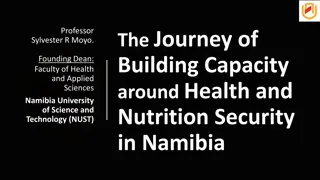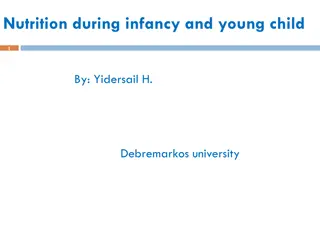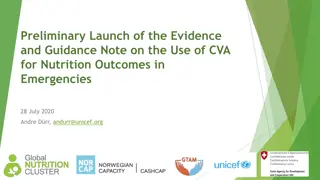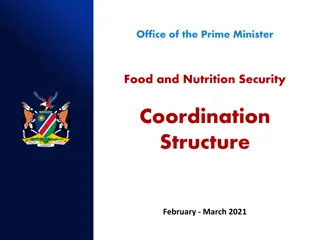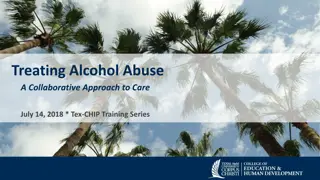Health Management Information for Nutrition 2017 Introductory Session Training
Participants in the Health Management Information for Nutrition 2017 training session will cover topics such as course objectives, introductions, training expectations, course norms, and training methodology. The training aims to build capacity in nutrition data collection, aggregation, reporting, and utilization over a duration of 5 days, structured around five modules. Key training materials include reference manuals, anthropometric equipment, HMIS data tools, and IEC materials. The session concludes with an invitation for questions and readiness to begin.
- Health Management Information
- Nutrition Training
- Capacity Building
- Data Collection
- Training Methodology
Download Presentation

Please find below an Image/Link to download the presentation.
The content on the website is provided AS IS for your information and personal use only. It may not be sold, licensed, or shared on other websites without obtaining consent from the author. Download presentation by click this link. If you encounter any issues during the download, it is possible that the publisher has removed the file from their server.
E N D
Presentation Transcript
HEALTH MANAGEMENT INFORMATION FOR NUTRITION 2017 Introductory Session Training in the Health Management Information System for Nutrition 1 HEALTH MANAGEMENT INFORMATION FOR NUTRITION 2017
Objectives By end of this session, participants should be able to: Know each other and complete the daily registration forms Identify leaders to support the training Understand course duration, structure, expectations, training methodology Determine course norms 2 HEALTH MANAGEMENT INFORMATION FOR NUTRITION 2017
Introductory Session Introductions Course leaders Chairperson Spiritual leader Energizer Welfare manager 3 HEALTH MANAGEMENT INFORMATION FOR NUTRITION 2017
Introductory Session, contd. Training expectations Course norms 4 HEALTH MANAGEMENT INFORMATION FOR NUTRITION 2017
Introductory Session, contd. Aim: Capacity building in nutrition data collection, aggregation, routine reporting, and utilization Duration: 5 days Structure: Five modules Overview of HMIS HMIS for nutrition Key nutrition data sources Routine nutrition data monitoring and reporting Nutrition data quality 5 HEALTH MANAGEMENT INFORMATION FOR NUTRITION 2017
Introductory Session, contd. Training methodology: Theory Practical Brain storming Group work Exercises/Drills Case scenarios 6 HEALTH MANAGEMENT INFORMATION FOR NUTRITION 2017
Introductory Session, contd Key training materials Reference manuals Anthropometric equipment Anthropometric charts/tables HMIS data tools (cards, registers, tally sheets, report forms) IEC materials 7 HEALTH MANAGEMENT INFORMATION FOR NUTRITION 2017
Any Questions? Let s get started! 8 HEALTH MANAGEMENT INFORMATION FOR NUTRITION 2017
HEALTH MANAGEMENT INFORMATION FOR NUTRITION 2017 Session 1.1 The Health Management Information System 1 HEALTH MANAGEMENT INFORMATION FOR NUTRITION 2017
Objectives By end of this session, participants should be able to: Explain the objectives of HMIS, its framework, and reporting structure Describe HMIS data sources, data flow, routine reports, and timelines of reporting 10 2 HEALTH MANAGEMENT INFORMATION FOR NUTRITION 2017
Brainstorming What is HMIS? What is the HMIS used for? 11 3 HEALTH MANAGEMENT INFORMATION FOR NUTRITION 2017
Introduction HMIS is an integrated system used by MOH, development partners, and stakeholders to collect relevant and functional information on a routine basis to monitor the Health Sector Strategic and Development Plan (HSSDP) indicators to enable planning, decision making, monitoring, and evaluation of the health care delivery system. It is designed to assist managers to undertake evidence- based decision making at all levels of the health care service delivery system. 12 4 HEALTH MANAGEMENT INFORMATION FOR NUTRITION 2017
Goal of HMIS To provide quality data that supports evidence-based decision making at all levels of the health care service delivery system in Uganda 13 5 HEALTH MANAGEMENT INFORMATION FOR NUTRITION 2017
Objectives of HMIS Provide quality data to support evidence-based decision making in the health sector Aid in setting performance targets at all levels of health care service delivery Assist in assessing performance at all levels of the health sector Encourage use of health information 14 6 HEALTH MANAGEMENT INFORMATION FOR NUTRITION 2017
Attributes of HMIS Relevant: HMIS is designed to be relevant to the policies and goals of the Government of Uganda. Functional: The data captured within the HMIS is to be used by management to inform evidence-based decisions aimed at improving the health of the population served. Integrated: There is one set of forms for collecting administrative data with no duplication of reporting. Routine: Information is collected on a routine basis from every health unit in all districts of the country. 15 7 HEALTH MANAGEMENT INFORMATION FOR NUTRITION 2017
Categories of HMIS Documentation HMIS manual: This is sub-divided into seven technical modules. The manual consists of all pre-primary and primary data collection tools (patient cards, registers, among others). HMIS database: This is a document that contains all relevant summary tables for summarizing data from the primary data collection tools. Indicator booklet: This contains indicator definitions, methods of data collection, frequency, calculation, and interpretation. 16 8 HEALTH MANAGEMENT INFORMATION FOR NUTRITION 2017
Uses of HMIS Planning Predicting epidemics Detecting epidemics Designing disease-specific interventions Monitoring work plan performance Allocating resources 17 9 HEALTH MANAGEMENT INFORMATION FOR NUTRITION 2017
Group Work/Presentation In groups of 5 7 participants, answer one of the following: Identify the various sources of HMIS data. Describe the flow of HMIS data in Uganda s health system. OR 18 10 HEALTH MANAGEMENT INFORMATION FOR NUTRITION 2017
HMIS Data Sources and Flow Sources of Data HMIS data are largely captured at health facility/ community levels depending on the point of contact between a health worker/health support and a patient/client. The data are collected using standardized data collection tools and aggregated at health facility, HSD, district, and finally at national level. Data at national level are accessed through the electronic system DHIS2 by stakeholders, depending upon acquisition of user access credentials. 19 11 HEALTH MANAGEMENT INFORMATION FOR NUTRITION 2017
Other Sources of Health Data 1. Administrative: Information on inventories, supervision, management meetings, etc. 2. Population-based health surveys: Mainly carried out by Uganda Bureau of Statistics (UBOS) and other institutions that generate data relative to populations (population studies) as a whole, e.g., UDHS, UNHS, among others. 3. Research institutions and academic data: Involves health systems research, clinical trials, and longitudinal community studies. 4. Sentinel sites. 20 12 HEALTH MANAGEMENT INFORMATION FOR NUTRITION 2017
Other Sources of Health Data, contd. 5. Civil registration and vital statistics system: Essential for providing quality data on births, deaths, and causes of death. 6. Population and Household Census: Carried out every 10 years and is the primary source of data on size of population(s), geographic distribution, and the social, demographic, and economic characteristics. Annual projections at national and sub-national level are provided by UBOS. 21 13 HEALTH MANAGEMENT INFORMATION FOR NUTRITION 2017
Categories of HMIS Data Tools Pre-primary tools: Contain the first contact information used to identify/locate a patient s details Primary tools: Record patient details on a daily basis; basis for evaluating health unit performance Secondary tools: Reports, summary of performance by programmatic area Management data: Used to evaluate health unit managerial functions 22 14 HEALTH MANAGEMENT INFORMATION FOR NUTRITION 2017
Categories of HMIS Data Collection Tools (Examples) Pre-primary Primary Secondary Management Registers Medical form 5 Record of management meetings Report forms - Out-patient Requests (lab, x- ray) - Notification (HMIS033a) - Inpatient Record of support supervision Treatment sheet - Weekly (HMIS 033b) - Antenatal Treatment follow- up form - Monthly (HMIS 105) - INR Tool for HMIS support supervision - Nutrition Addendum (HMIS 009) - Laboratory Patient cards - Child Referral notes Inventory tools - Quarterly (HMIS 106a) - Operating theatre Medical and other health supplies - Annual (HMIS form 107) Log books - Daily consumption log Summary tables Finance and accounting - Annual Record books - Monthly - Cash analysis 23 15 HEALTH MANAGEMENT INFORMATION FOR NUTRITION 2017
Data Communication and Feedback All health service delivery data and information must be routed through the MOH Division of Health Information for validation, analysis, and dissemination. Feedback mechanisms on reported data flow from top to bottom (Ministry of Health to the community level). 24 16 HEALTH MANAGEMENT INFORMATION FOR NUTRITION 2017
HMIS reporting structure 25 17 HEALTH MANAGEMENT INFORMATION FOR NUTRITION 2017
Routine Reports and Their Timeliness Routine reports (examples) Timeline of reporting by the HF Weekly report (HMIS 033b) Every Monday Monthly reports (HMIS 105, HMIS 009, HMIS 108) 7th of the next month Due 7th October, 7th January, 7th April, 7th July Quarterly report (HMIS 106a) Annual report (HMIS 107) Due 7th August 26 18 HEALTH MANAGEMENT INFORMATION FOR NUTRITION 2017
End of Session 27 19 HEALTH MANAGEMENT INFORMATION FOR NUTRITION 2017
HEALTH MANAGEMENT INFORMATION FOR NUTRITION 2017 Session 1.2 The District Health Information System (DHIS2) 28 1 HEALTH MANAGEMENT INFORMATION FOR NUTRITION 2017
Session Objectives By the end of this session, participants should be able to: Describe the evolution of eHMIS Discuss the implementation of DHIS2 in Uganda Explain the key dimensions of DHIS2 Navigate the DHIS2 software 29 2 HEALTH MANAGEMENT INFORMATION FOR NUTRITION 2017
Evolution of eHMIS HMIS was introduced in 1985. With the introduction of the Health Sector Strategic and Development Plan (HSSDP), the HMIS was revised to provide data to monitor the performance of the HSSDP. In 2005, age and gender disaggregation and Epi-Info- based system was introduced. In 2007, the District-HIS (DHIS version 1) was introduced. It was upgraded to web-based HMIS (w-HMIS) in 2008. In 2011/2012, a National electronic system, DHIS version 2 (DHIS2) was approved in Uganda. 30 3 HEALTH MANAGEMENT INFORMATION FOR NUTRITION 2017
DHIS2 Overview A web-based application used for collection, validation, analysis, and presentation of aggregate statistical data tailored to integrated health information management activities. Generic in nature, the contents can be customized without programming. Developed by the Health Information Systems Programme (HISP) project as an open source and globally distributed program. 31 4 HEALTH MANAGEMENT INFORMATION FOR NUTRITION 2017
DHIS2 Implementation in Uganda With support from implementing partners, MOH- Division of Health Information (DHI) rolled out to all districts, Regional Referral Hospitals, and a few Health Sub-districts and Health Units starting in 2011. 32 5 HEALTH MANAGEMENT INFORMATION FOR NUTRITION 2017
Accessing DHIS2 DHIS2 is accessible on a standard web browser. URL: http://hmis2.health.go.ug/ MOH website: health.go.ug To access the system, type the URL in a web browser and a Login Page will appear. Username and Password are required to gain entry to the main features of the system. A Standard Operating Procedure (SOP) on getting access to the system is in place at the MOH/DHI or MOH Web Portal. 33 6 HEALTH MANAGEMENT INFORMATION FOR NUTRITION 2017
Navigating DHIS2 DHIS2 has two main menu items: The Apps Menu (Most features in DHIS2 appear as independent application) The Profile Menu (Account settings, Help sub- menu and Log out of the system) For ease of use, a search box is provided to quickly search for and display a feature of choice. 34 7 HEALTH MANAGEMENT INFORMATION FOR NUTRITION 2017
Features of DHIS2Demonstration And Many And Many More! More! 35 8 HEALTH MANAGEMENT INFORMATION FOR NUTRITION 2017
Benefits of DHIS2 Designed to facilitate smooth harmonized national reporting. Facilitates data use and sharing with stakeholders at various levels. Can be customized to include additional requirements. Enables data entry and reporting at various levels and for different reporting cycles. 36 9 HEALTH MANAGEMENT INFORMATION FOR NUTRITION 2017
Benefits of DHIS2, contd. Provides different applications for data validation for improvement of data quality. Is a simple, flexible, and open-source information system with easy to use visualization features such as GIS, charts and pivot tables. 37 10 HEALTH MANAGEMENT INFORMATION FOR NUTRITION 2017
DHIS2 Terminology Data elements Data sets Indicators Organisation units (org units) Reporting periods 38 11 HEALTH MANAGEMENT INFORMATION FOR NUTRITION 2017
DHIS2 Terminology, contd. Data element: Unit of data entry Data set: A set of related data elements that are collected together An equivalent of a data entry form Not linked directly to the data What? Can be modified at any time Focus is on the data output, not where it came from Data elements can be part of many datasets 39 12 HEALTH MANAGEMENT INFORMATION FOR NUTRITION 2017
DHIS2 Terminology, contd. Indicators Variables that help to measure changes, directly or indirectly (WHO 1981). A combination of one or more data elements They are tools used to convert raw data into information . 40 13 HEALTH MANAGEMENT INFORMATION FOR NUTRITION 2017
DHIS2 Terminology, contd. Organisation Unit The location of the data, the geographical context, is represented as organisation units. Organisation units can be either a health facility or department/sub-unit that provides services or an administrative unit that represents a geographical area (e.g., a district) . Where? 41 14 HEALTH MANAGEMENT INFORMATION FOR NUTRITION 2017
DHIS2 Terminology, contd. Reporting period The frequency of reporting a set of defined indicators/variables through a dataset. Daily Weekly Monthly When? Quarterly Bi-annual Annual (can either be calendar or financial) 42 15 HEALTH MANAGEMENT INFORMATION FOR NUTRITION 2017
DHIS2 Core Dimensions DHIS2 dimensions can be summarized as: What data element Where organization unit When time period Illustration WHAT WHERE WHEN Data element Organisation Unit Time Period Value No. of clients with moderate acute malnutrition Mukono HCIV Dec-09 22 43 16 HEALTH MANAGEMENT INFORMATION FOR NUTRITION 2017
DHIS2 Data Model: Data input = Data output Overview 44 17 HEALTH MANAGEMENT INFORMATION FOR NUTRITION 2017
In summary, with DHIS2 we can know 45 18 HEALTH MANAGEMENT INFORMATION FOR NUTRITION 2017
Practical Session 1. Data Entry of HMIS 105, HMIS 106a Nutrition Data Divide into groups of 5-6 participants. Create a folder on your desktop and name it nutrition training . Use the username and password provided to access (enter) the system (DHIS2) On the dashboard, click on the Apps icon and choose the data entry module. On the data entry screen, select the dimensions (what, when, where) of interest. Using the dummy tools provided, enter the nutrition data elements into the data set provided (either HMIS 105 or HMIS 106a, not both). 46 19 HEALTH MANAGEMENT INFORMATION FOR NUTRITION 2017
Practical Session 2. In groups of 5 6 participants, select a district of reference and try out case scenario set 4 (Reference Manual page 74). Prepare to present in plenary. 47 20 HEALTH MANAGEMENT INFORMATION FOR NUTRITION 2017
Group Presentations Group 1: Report rate summary Group 2: Pivot table Group 3: Data Visualizer Group 4: Dashboard 48 21 HEALTH MANAGEMENT INFORMATION FOR NUTRITION 2017
End of Session 49 22 HEALTH MANAGEMENT INFORMATION FOR NUTRITION 2017



















